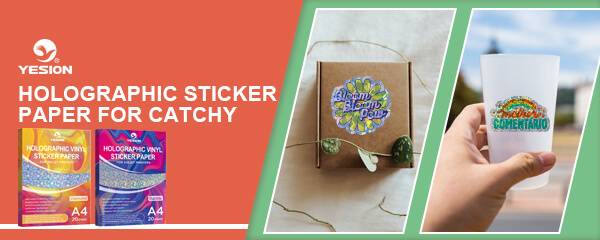
Some Unique Crafting Ideas Using Holographic Sticker Paper
2023-08-25
The Weight or Thickness of Inkjet Photo Paper Affects Print Quality
2023-09-01Holographic sticker paper can be applied to a wide range of packaging materials. Its adhesive backing allows for easy application on various surfaces.
What types of packaging materials can holographic sticker paper be applied?
Here are some commonly used packaging materials where holographic sticker paper can be applied:
Cardboard Boxes: Holographic stickers can be easily applied to cardboard boxes commonly used for packaging products. The smooth surface of cardboard provides a suitable base for the stickers to adhere to.
Plastic Containers: Holographic stickers can be applied to plastic containers, such as bottles, jars, or tubes. The adhesive on the sticker paper adheres well to plastic surfaces, enhancing the visual appeal of the packaging.
Glass Bottles: Holographic stickers can be used to decorate glass bottles, adding a unique and eye-catching element to the packaging. As glass surfaces are generally smooth, holographic stickers adhere well to them.
Metal Packaging: Holographic stickers can be applied to various metal packaging materials, including tin cans, aluminum containers, or metal boxes. Ensure that the surface is clean and free of any oils or residues before applying the sticker to ensure proper adhesion.
Flexible Packaging: Holographic stickers can be applied to flexible packaging materials such as pouches, sachets, or wrappers. It is essential to choose holographic sticker paper with a flexible adhesive that can conform to the shape of the packaging material without peeling off.
Paper Bags and Wrapping: Holographic stickers can be used to add decorative elements to paper bags or wrapping materials. They can be applied directly to the surface, enhancing the visual appeal and making the packaging more attractive.
It’s important to note that the effectiveness of holographic sticker paper on different packaging materials may vary.
Step-by-Step Guide: Applying Holographic Stickers to Different Packaging Types
Here’s a step-by-step guide on how to apply holographic stickers to different packaging types:
Prepare the Packaging Surface:
Ensure that the packaging surface is clean, dry, and free from dust, dirt, oils, or residues. Use a soft cloth or alcohol wipes to clean the surface thoroughly.
Choose the Right Holographic Sticker:
Select holographic sticker paper that suits your packaging material and application requirements. Consider factors such as adhesive quality, flexibility (if applicable), and desired visual effect.
Plan the Sticker Placement:
Determine where you want to place the holographic stickers on the packaging. Consider the design and layout of your packaging to ensure the stickers enhance the overall aesthetic appeal.
Peel the Sticker:
Carefully peel off the holographic sticker from its backing sheet, starting from one corner. Avoid touching the adhesive side with your fingers to prevent any oils or contaminants from affecting the adhesion.
Apply the Sticker:
Position the holographic sticker onto the desired location on the packaging surface. Start from one edge and gradually press it down, smoothing it out as you go along. Avoid applying excessive pressure, as it may cause the sticker to stretch or wrinkle.
Smooth Out Air Bubbles and Wrinkles:
Use a soft cloth or your fingertips to gently smooth out any air bubbles or wrinkles that may have formed during the application process. Start from the center and work your way towards the edges to ensure a smooth and even application.
Secure the Adhesion:
Press firmly on the holographic sticker to ensure proper adhesion to the packaging surface. Pay extra attention to the edges and corners to prevent any lifting or peeling.
Inspect and Adjust:
Carefully inspect the applied holographic sticker to ensure it is securely attached and free from any defects or imperfections. If necessary, reposition or adjust the sticker while the adhesive is still fresh and pliable.
Repeat for Additional Stickers:
If you are applying multiple holographic stickers to the packaging, repeat the above steps for each sticker, ensuring proper placement, smooth application, and secure adhesion.
Allow Sufficient Drying Time:
Depending on the adhesive properties of the holographic sticker paper, allow sufficient drying or curing time before handling or packaging the finished products. Refer to the manufacturer’s instructions for recommended drying times.
By following these step-by-step instructions, you can effectively apply holographic stickers to different packaging types and enhance the visual appeal of your products. Remember to consider the specific requirements of your packaging materials and choose high-quality holographic sticker paper for the best results.
What factors affect the adhesion and overall appearance of holographic stickers on different packaging materials?
Several factors can affect the adhesion and overall appearance of holographic stickers on different packaging materials. Here are some key factors to consider:
Surface Texture: The texture of the packaging material can impact the adhesion of holographic stickers. Smooth surfaces, such as glass or plastic, provide better adhesion compared to rough or uneven surfaces like corrugated cardboard. The adhesive on the sticker needs a sufficiently smooth and flat surface to bond properly.
Material Porosity: The porosity of the packaging material can affect adhesion. Non-porous materials like plastic or glass provide a better surface for the adhesive to bond with, ensuring a secure attachment. However, highly porous materials like uncoated paper or rough cardboard may absorb the adhesive, resulting in weaker adhesion.
Surface Cleanliness: The cleanliness of the packaging material’s surface is crucial for proper adhesion. Dust, dirt, oils, or residues on the surface can hinder the adhesive’s effectiveness and lead to poor adhesion. It’s important to ensure that the packaging surface is clean and free from any contaminants before applying holographic stickers.
Adhesive Quality: The quality of the adhesive on the holographic sticker paper plays a significant role in its adhesion. High-quality adhesive is designed to bond well with various surfaces and maintain its stickiness over time. It’s advisable to choose holographic sticker paper with a reliable adhesive specifically formulated for packaging applications.
Packaging Material Flexibility: If the packaging material is flexible, such as pouches or wrappers, it’s important to choose holographic sticker paper with a flexible adhesive that can withstand the material’s movement without peeling off or losing adhesion. Flexible packaging requires stickers that can conform to the contours of the material without compromising their effectiveness.
Environmental Conditions: Environmental factors, such as temperature and humidity, can affect the adhesion of holographic stickers. Extreme temperatures or high humidity levels can weaken the adhesive or cause it to lose its stickiness. It’s important to consider the intended storage and transportation conditions of the packaged products to ensure the holographic stickers can withstand the environment.
Application Technique: The application technique used to apply the holographic stickers can also impact their adhesion and appearance. Care should be taken to ensure the stickers are applied smoothly, without air bubbles or wrinkles, and firmly pressed onto the packaging surface for proper adhesion.
By considering these factors and choosing the appropriate holographic sticker paper and application technique, you can maximize adhesion and achieve the desired visual impact on different packaging materials.
Related:
Some Unique Crafting Ideas Using Holographic Sticker Paper?
Holographic Vinyl Sticker Paper: Adding Shine to Your Designs


